Labels for Safety, Visuals and Facility ID Desktop Printers
Labels for Product, Wire and Lab ID Benchtop Printers
Labels for Safety, Visuals and Facility ID Desktop Printers
Labels for Product, Wire and Lab ID Benchtop Printers
Safety and Facility ID Desktop Printers
Product, Wire and Lab ID Benchtop Printers
Barcode Scanner and Printer Kits
Barcode Scanner and Printer Kits
PaintStripe Floor Marking Stencils
Valve Lockouts & Hose Lockouts
Group Lock Boxes & Permit Control
Brady Safety Lockout Tagout Services
Pipe Marker Accessories & Mounting Brackets
Maintenance and Production Tags
Calculators and Assessment Tools
Product Finders and Data Sheets
With so many hardware options available for your lockout tagout program, it can be hard to know which padlock is right for your specific situation. Add on the complexities of managing lockout tagout programs for multiple departments or facilities and the options can be downright overwhelming.
To help you sort through the confusion, we’ve developed a list of important considerations when selecting your lockout tagout padlocks.
The first step is to find the right padlock type for your specific application. There are three material options to consider:
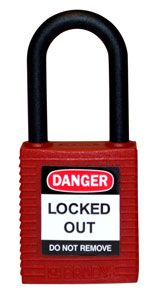
Nylon padlocks
Nylon padlocks have a lightweight nylon body with either a steel or nylon shackle that's ideal for industrial environments. The nylon padlocks with nylon shackle are plastic, non-conductive and non-sparking making it great for electrical and indoor applications.
Compact padlocks are also available for smaller spaces. The extremely compact and lightweight design with non-conductive and non-sparking nylon shackle is ideal for small spaces for electrical contractors, maintenance and electricians.
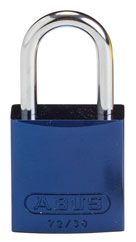
Aluminum padlocks
The aluminum padlock with steel shackle provides both corrosion resistance, as well as added durability for tougher industrial environments and outdoor use.
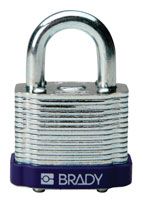
Steel padlocks
Steel padlocks are made with reinforced laminated steel that withstands severe physical abuse and a hardened steel shackle with individually coated body plates for superior rust protection.
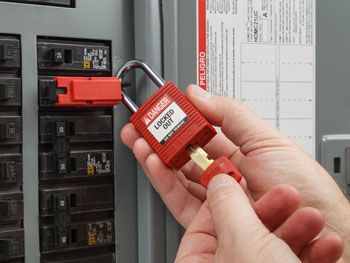
The next consideration includes whether your program would benefit from the use of traditional safety padlocks vs. Brady SafeKey Lockout Padlocks. What's the difference?
Color-coding, engraving or lock labels are some of the ways larger organizations communicate the status of machine maintenance, reduce losses and ensure they are compliant. Learn more about how each approach may benefit your lockout tagout program:
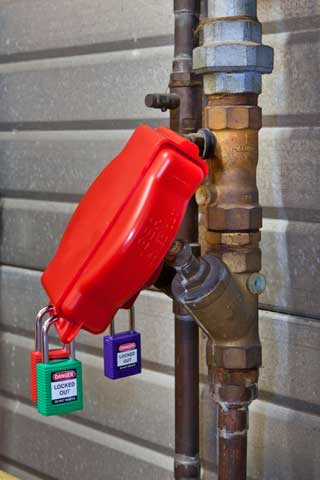
Finding the right key system for your lockout tagout program ensures the right people have access to lockout equipment during maintenance. The guidelines below will help you determine the right keyed alike or keyed different option for your unique needs:
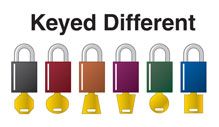
Keyed different padlocks
Each padlock has its own unique key. Ideal for ensuring there is no potential key duplication when multiple maintenance personnel need to lockout equipment.
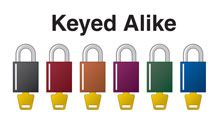
Keyed alike padlocks
Each padlock can be opened with the same key. This option is beneficial when multiple locks are assigned to a single employee. However, it’s important to remember that under OSHA regulations no employee should be able to open a lock applied by someone else. Therefore, keyed alike locks from the same set should never be distributed to multiple employees.
This type of lock is mostly used when a maintenance individual is responsible for multiple machines or isolation points. It makes it easier to find the right key and reduces the number of keys on a key ring.
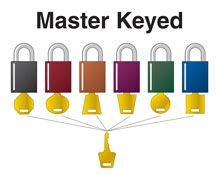
Master keyed padlocks
The master key can open all locks including keyed alike and keyed different locks. This allows supervisors to easily remove a lock in the event of an emergency. In order for employees to retain exclusive control, master keys should be kept in a secure location that is only accessible to management.
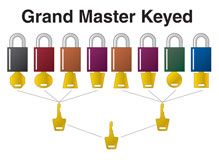
Grand master keyed padlocks
The grand master key can open all locks grouped into two or more master keyed systems. This option is best for applications with larger teams requiring multiple levels of supervisory access. In order for employees to retain exclusive control, grand master keys should be kept in a secure location that is only accessible to management.
Charting your locks and keys is recommended when the end user requires no risk of key duplication or for custom padlock options such as master keyed and grand master keyed padlocks. Brady can track or “chart” your key codes upon request to simplify ordering replacement locks and to avoid duplicates when ordering additional locks.

When you’re managing lockout tagout programs for multiple departments or facilities, standardizing your program can provide a number of benefits to your organization. The most successful lockout tagout programs include the complete safety picture — locks, tags and devices, as well as proper lockout procedures, program documentation, employee training, periodic inspections or other procedural elements.
By creating a standard, it makes ordering new locks easier and faster because you know the exact lock you need to order for each application. It can also simplify training because a standardized program outlines what locks to use and where they are located.
If you’re still struggling to determine the best hardware and products for your lockout tagout program, we’re here to help. Partner with our in-house team of lockout tagout experts who can assist you in creating a sustainable and compliant safety program supported by:
Learn more about our lockout tagout solutions at www.bradyid.com/safety-services/lockout-tagout.

Learn more about Lockout Tagout compliance with “The Safety Professionals Expanded Guide to LOCKOUT TAGOUT”
Download
Learn what equipment you need to effectively use lockout tagout in your facility with our downloadable checklist.
Download
See what other Safety Managers are most commonly asking about the lockout tagout standard.
View FAQ's